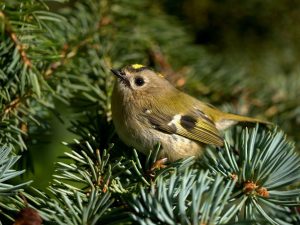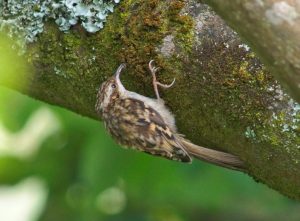Ireland’s Wildlife contributor Albert Nolan takes a walk around the woodland nature trail at the Glen of Aherlow in County Tipperary… and discovers a hidden world of wildlife.
 Dark, threatening clouds were rolling across the Galtees and spilling into the Glen of Aherlow as I pulled into the car park. Showers of rain splattered against the car testing my resolve as I slipped into my walking gear.
Dark, threatening clouds were rolling across the Galtees and spilling into the Glen of Aherlow as I pulled into the car park. Showers of rain splattered against the car testing my resolve as I slipped into my walking gear.
Not every day can be sunny but wildlife is resilient and beneath the weather and the trees nature is stirring into life and waiting to be discovered. The Glen of Aherlow has some fabulous walks and today I was taking the nature trail through the woods.
 The view from the car park is beautiful and draws your eyes up to the peaks of the Galtees. The native forests have long since gone but hedgerows hold the landscape together and provide a vital habitat for birds, animals and insects. Birds are in full song and I hear a song thrush, great tit and robin. Gorse is also in flower and its yellow flowers will be visited by early bumblebees.
The view from the car park is beautiful and draws your eyes up to the peaks of the Galtees. The native forests have long since gone but hedgerows hold the landscape together and provide a vital habitat for birds, animals and insects. Birds are in full song and I hear a song thrush, great tit and robin. Gorse is also in flower and its yellow flowers will be visited by early bumblebees.
I descended down the steep steps and spotted a nest box up on a tree. Lack of suitable nest sites has an effect on birds as they have to fight for scarce resources and use marginal sites that are more exposed to the elements and predators. Putting up nest boxes is a great way to help our birds.
Bramble, moss and bracken carpet the forest floor and this understory is vital for the health of the woods. Holly has also been spread by birds and in some parts has formed an impenetrable tangle. This acts as a nursery for the taller trees like oak and protects them for grazing animals like deer until they reach a safe height.
By a small mountain stream a cheery tree has been planted by girls from St Michael’s Girls National School in Tipperary as part of National tree week. Several years later the tree has shot up and many of those young environmentalists would be in secondary school by now.
Tall Scots pine tower up into the sky and their rough bark is ideal for insects and their larvae. I hear goldcrests singing and these will forage in the cracks of the bark for food. They keep to dense cover and are very hard to see. A small oak is growing by the edge of the track. These are slow growing and will eventually win the battle through the centuries and dominate the skyline.
The wind is very strong and the tops of the trees are swaying. Down on the ground the woods filter the wind and provide excellent shelter. A Song thrush is singing and his song echoes along the path. The Heather has finished flowering and this is an important source of nectar for early insects.
 I push deeper into the woods and come across a mountain ash tree. These are a common small tree and in autumn it produces delicious red berries for birds. Honeysuckle has wrapped itself around the tree and this must be an old embrace as the bark of the tree has grown over the stem of the climber. honeysuckle releases its scent at dusk and this attracts night flying moths. The forest floor is damp and a green carpet of moss covers the ground. Another goldcrests is singing but I can’t see him as he remains hidden in the shadows.
I push deeper into the woods and come across a mountain ash tree. These are a common small tree and in autumn it produces delicious red berries for birds. Honeysuckle has wrapped itself around the tree and this must be an old embrace as the bark of the tree has grown over the stem of the climber. honeysuckle releases its scent at dusk and this attracts night flying moths. The forest floor is damp and a green carpet of moss covers the ground. Another goldcrests is singing but I can’t see him as he remains hidden in the shadows.
Ivy has scrambled up a Scots pine tree and is nearly at the top. Woodland is it natural habitat and it provides hard black berries in the spring for birds and this helps them prepare for the breeding season. It flowers late in the summer and this is one of the last sources of nectar for late flying insects.
I reach my turning point and head back towards the car. Beautiful oak and beech trees tower above the path. Oak is a true community with over 500 different species associated with it. Growing nearby there is a small ash tree.
The unseen world and its workers is often the most important for the health of our environment. Cut branches have been stacked by the edge of the path and fungi are hard at work. They will slowly digest the timber and release the trapped nutrients. Bramble is another excellent plant for wildlife. Its thorns form a protective barrier for nesting birds and in late summer delicious blackberries hang from the stems. These are devoured by birds, foxes and of course people. The flowers are large and white and provide plenty of nectar for butterflies and bees.
I carefully search the bramble leaves and find the tunnel of a tiny moth larva. The adult lays its egg on the edge of the leaf and when the larva hatches it lives inside the leaf. You can observe its short course through life by following the path of its tunnel. This starts off narrow and gets wider as the caterpillar grows and emerges into the world to continue the life cycle. This creature has made a very wise choice as brambles are immune to all creatures except man.
Coloured lichens hang from the branches of a birch tree. There are orange, green and white and they thrive in the humid environment of the woods. White tree bracket fungi are growing on the trunk of a tree and these are a useful indication that the tree is reaching the end of its life. I peel back some of its bark to expose its unseen lodgers. A tiny black spider is guarding silken bundles of tiny eggs and does not move even from this giant creature.
I move on and pause beneath a tall tree to let a shower pass. While I wait I look underneath a Holly leaf and find tiny orange insects with a black edge to their bodies. Some of the leaves have tunnels from insects and a nearby rotting log reveals a whole host of mini beasts. All of these creatures are part of the fabric of the woods and without them it would not survive for very long. I scratch a green lichen on the bark and it reveals a white centre.
 A wren breaks into song and is soon followed by a robin. A quick movement catches my eye and I am thrilled to see a teecreeper slowly working his way up the trunk of a tree. They have a curved bill and use this to prise out insects that live in the bark. The long fronds of Harts tongue fern peer out from the bottom of the steps. They like damp places and all the rain running down the hill creates the ideal place for them to grow.
A wren breaks into song and is soon followed by a robin. A quick movement catches my eye and I am thrilled to see a teecreeper slowly working his way up the trunk of a tree. They have a curved bill and use this to prise out insects that live in the bark. The long fronds of Harts tongue fern peer out from the bottom of the steps. They like damp places and all the rain running down the hill creates the ideal place for them to grow.
The sun comes out as I emerge into the light and the day looks like it is going to pick up. The grassland around the picnic benches is unimproved and I see the leaves of several flowers waiting for their moment to flower. A small area could be left uncut and this would be very attractive for butterflies, bees and people.
A few Daises are in flower by the edge of the path and thin white lichens are growing on the stones.
Discovering nature nestled on our doorstep makes for a very rewarding stroll on a soggy mid- week afternoon. From the smooth tops of the Galtees to the tall spires of the trees nature is all around us. So why not put on your walking gear and head out to explore the amazing world of nature










2 comments
Pat murphy
Brilliant stuff as usual AlBert great description of Aherlow wildlife and fauna.
Susan
Great piece ?